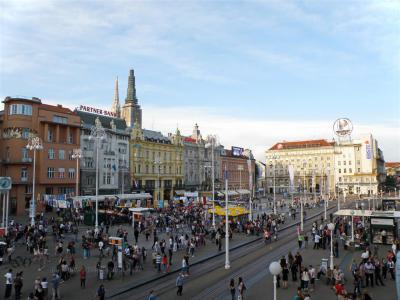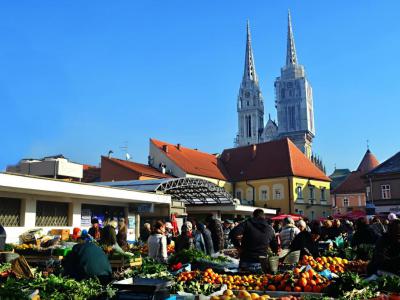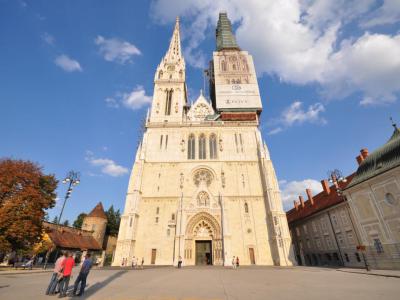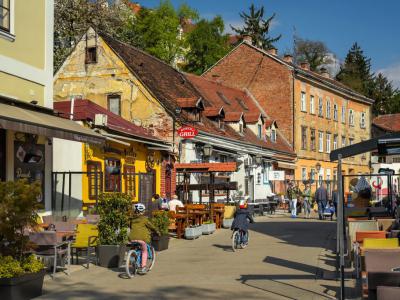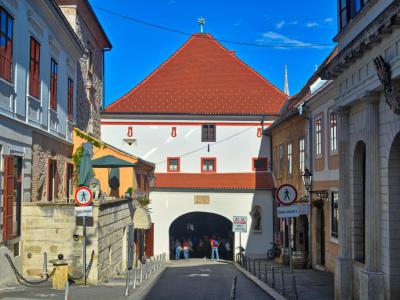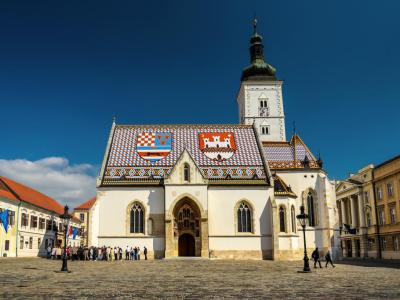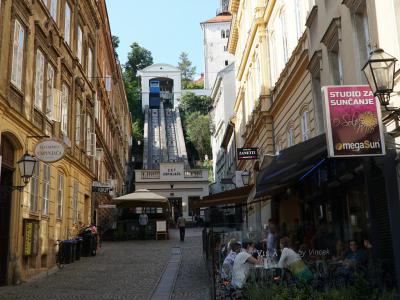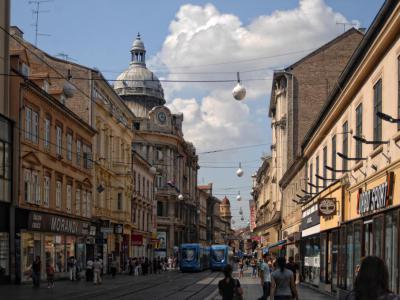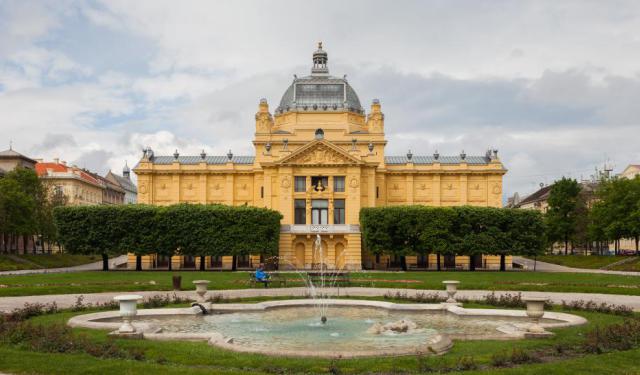Upper Town Walking Tour (Self Guided), Zagreb
Andautonia was a Roman settlement near the location of today's Zagreb. Historical record attests to the name "Zagreb" in 1134, referring to the founding of the diocese of "Kaptol" by sainted King Ladislaus in 1094. Kaptol is the "Upper Town" of Zagreb. The "Lower Town" is "Gradec."
Upper Town centered around Zagreb Cathedral consecrated in 1217. Upper Town was the home of the clergy, while Lower Town was home to artisans and merchants. The two settlements were separated by Medvescak Creek, now represented by Mandvescak Fountain in Ban Jelacic Square, the main square of Zagreb.
Upper Town forms a medieval neighborhood of churches, palaces, museums, and galleries. Starting from Ban Jelacic Square, the historic district is easily explored on foot. The 13th-century Stone Gate holds a shrine to the Virgin Mary that did not burn in the devastating fires of the 1600s.
The funicular on Tomiceva Street lifts visitors to St. Mark's Square in the Upper Town. Here the Order of The Silver Dragon re-enacts the historic battles of Lower Town vs. Upper Town. The Archeological Museum has almost 450,000 artifacts and monuments. The Modern Gallery has over 10,000 works of art.
The most impressive building of Upper Town is the 11th-century Zagreb Cathedral, but St. Mark's Church's colorful tiled roof is also unforgettable. The Museum of Broken Relationships is a new approach to love gone bad. Lotrscak Tower still protects the Upper Town, firing a cannon every day at noon.
Markets and restaurants on Tkalciceva Street offer specialties of Zagreb. Products include crystal, china, ceramics, wicker, wines, and gastronomic delights.
Zagreb is a festival venue year-round. The open-air INmusic Festival occurs in June. The Zagreb Jazz Festival occurs in clubs and concert halls. There are twenty or more permanent and seasonal theaters.
Visit Dolac Market. Under the red umbrellas, find a cornucopia of fruits, vegetables, cheeses, wines, and pastries. Walk along Ilica Street, munch on a walnut roll, and have an espresso. When the cannon goes BOOM, it's time for lunch. Enjoy.
Upper Town centered around Zagreb Cathedral consecrated in 1217. Upper Town was the home of the clergy, while Lower Town was home to artisans and merchants. The two settlements were separated by Medvescak Creek, now represented by Mandvescak Fountain in Ban Jelacic Square, the main square of Zagreb.
Upper Town forms a medieval neighborhood of churches, palaces, museums, and galleries. Starting from Ban Jelacic Square, the historic district is easily explored on foot. The 13th-century Stone Gate holds a shrine to the Virgin Mary that did not burn in the devastating fires of the 1600s.
The funicular on Tomiceva Street lifts visitors to St. Mark's Square in the Upper Town. Here the Order of The Silver Dragon re-enacts the historic battles of Lower Town vs. Upper Town. The Archeological Museum has almost 450,000 artifacts and monuments. The Modern Gallery has over 10,000 works of art.
The most impressive building of Upper Town is the 11th-century Zagreb Cathedral, but St. Mark's Church's colorful tiled roof is also unforgettable. The Museum of Broken Relationships is a new approach to love gone bad. Lotrscak Tower still protects the Upper Town, firing a cannon every day at noon.
Markets and restaurants on Tkalciceva Street offer specialties of Zagreb. Products include crystal, china, ceramics, wicker, wines, and gastronomic delights.
Zagreb is a festival venue year-round. The open-air INmusic Festival occurs in June. The Zagreb Jazz Festival occurs in clubs and concert halls. There are twenty or more permanent and seasonal theaters.
Visit Dolac Market. Under the red umbrellas, find a cornucopia of fruits, vegetables, cheeses, wines, and pastries. Walk along Ilica Street, munch on a walnut roll, and have an espresso. When the cannon goes BOOM, it's time for lunch. Enjoy.
How it works: Download the app "GPSmyCity: Walks in 1K+ Cities" from Apple App Store or Google Play Store to your mobile phone or tablet. The app turns your mobile device into a personal tour guide and its built-in GPS navigation functions guide you from one tour stop to next. The app works offline, so no data plan is needed when traveling abroad.
Upper Town Walking Tour Map
Guide Name: Upper Town Walking Tour
Guide Location: Croatia » Zagreb (See other walking tours in Zagreb)
Guide Type: Self-guided Walking Tour (Sightseeing)
# of Attractions: 10
Tour Duration: 1 Hour(s)
Travel Distance: 1.8 Km or 1.1 Miles
Author: jenny
Sight(s) Featured in This Guide:
Guide Location: Croatia » Zagreb (See other walking tours in Zagreb)
Guide Type: Self-guided Walking Tour (Sightseeing)
# of Attractions: 10
Tour Duration: 1 Hour(s)
Travel Distance: 1.8 Km or 1.1 Miles
Author: jenny
Sight(s) Featured in This Guide:
- Ban Jelačić Square
- Dolac Market
- Zagreb Cathedral
- Tkalčićeva Street
- Kamenita Vrata (The Stone Gate)
- Saint Mark's Church and Square
- Museum of Broken Relationships
- Lotršcak Tower
- Zagreb Funicular
- Ilica Street
1) Ban Jelačić Square (must see)
Ban Jelacic Square is named for Josip Jelacic, Ban (ruler) of Croatia and leader of Croatian independence from Austria in the 19th century. The name, locally, is Jelacic Plac. It is in the center of Zagreb's downtown pedestrian zone. It is located below the early medieval settlements of Gradec (1242) and Kaptol (1094), south of Dolac Market.
In 1641 it became necessary to create a new marketplace outside the old nucleus of Gradec and Kaptol, near the spring of Mandusevec. Initially called Mandusevec, the square's name was later changed to Harmica. The square became Ban Jelacic Plac in 1848.
A statue of Josip Jelacic on his horse, created by Austrian sculptor Anton Dominik Fernkorn, was erected by the Austrian administration. In 1947 it was removed by the Communist authorities, who renamed the place "Republic Square."
When the World University Games were held in Zagreb in 1987, the city was renovated and revitalized. The square was repaved in stone blocks and pedestrianized. The Mandusevec Fountain and the Mandusevec Spring, buried in 1898, were uncovered. In 1990 the Communists era ended, and Josip Jelacic, on his trusty steed, returned to the square.
At Christmas time, Ban Jelacic Square is adorned with trees and lights illuminate the facades of the surrounding antique Classicist, Secessionist, and Modernist buildings.
In 1641 it became necessary to create a new marketplace outside the old nucleus of Gradec and Kaptol, near the spring of Mandusevec. Initially called Mandusevec, the square's name was later changed to Harmica. The square became Ban Jelacic Plac in 1848.
A statue of Josip Jelacic on his horse, created by Austrian sculptor Anton Dominik Fernkorn, was erected by the Austrian administration. In 1947 it was removed by the Communist authorities, who renamed the place "Republic Square."
When the World University Games were held in Zagreb in 1987, the city was renovated and revitalized. The square was repaved in stone blocks and pedestrianized. The Mandusevec Fountain and the Mandusevec Spring, buried in 1898, were uncovered. In 1990 the Communists era ended, and Josip Jelacic, on his trusty steed, returned to the square.
At Christmas time, Ban Jelacic Square is adorned with trees and lights illuminate the facades of the surrounding antique Classicist, Secessionist, and Modernist buildings.
2) Dolac Market
The Dolac Market located a few yards from Ban Jelacic Square, the main square of Zagreb, is a popular farmer's market. It consists of an open market of stalls on a raised square reached by stairs from a sheltered market below. It is immediately behind Ban Jelacic Square in the oldest part of Zagreb.
The market has been a main trading post since 1930. Farmers sell homemade foods, fruits, and vegetables in the open market. In the covered market below, there is a mixed crowd of butchers and fishmongers vying among elderly ladies selling cheeses and cream, flowers, and lace. Nearby, the renovated fish market, Ribarnica, now sells produce.
Around the square, small bars and luncheonettes offer "gableci," lunches at a discount. A mezzanine has been added in the indoor section of the market. Florists are on the top level, where the Dolac meets Opatinova Park.
Strolling through the market, noshing on cream cheese with paprika and onions with cornbread, meet the kumicas, the women stall managers. A kumica is part trader and part godmother. By the market entrance is a bronze Kumica Barica Statue with a basket on her head. The statue is the work of sculptor Stjepan Gračan.
At the back of the hall are buckets of sauerkraut (finely cut raw cabbage that has been fermented by various lactic acid bacteria). In two bars at each end of the hall, hungry traders dig into cabana goulash after a very busy morning. Next door, sit on the terrace, munching on grilled sardines chased with wine, and watch the Dolac in action.
The market has been a main trading post since 1930. Farmers sell homemade foods, fruits, and vegetables in the open market. In the covered market below, there is a mixed crowd of butchers and fishmongers vying among elderly ladies selling cheeses and cream, flowers, and lace. Nearby, the renovated fish market, Ribarnica, now sells produce.
Around the square, small bars and luncheonettes offer "gableci," lunches at a discount. A mezzanine has been added in the indoor section of the market. Florists are on the top level, where the Dolac meets Opatinova Park.
Strolling through the market, noshing on cream cheese with paprika and onions with cornbread, meet the kumicas, the women stall managers. A kumica is part trader and part godmother. By the market entrance is a bronze Kumica Barica Statue with a basket on her head. The statue is the work of sculptor Stjepan Gračan.
At the back of the hall are buckets of sauerkraut (finely cut raw cabbage that has been fermented by various lactic acid bacteria). In two bars at each end of the hall, hungry traders dig into cabana goulash after a very busy morning. Next door, sit on the terrace, munching on grilled sardines chased with wine, and watch the Dolac in action.
3) Zagreb Cathedral (must see)
In 1093, king and warrior-saint Ladislaus I of Hungary moved the seat of a bishop from Sisak to Zagreb. He declared the church in Zagreb to be a cathedral. Reconstruction began at once and continued after the death of Ladislaus in 1095. The Zagreb Cathedral was consecrated by King Andrew II of Hungary in 1217.
The building was destroyed by Mongol invaders in 1242 and rebuilt shortly thereafter. The continuing threat of the Ottoman Empire prompted the structure of walls and a watchtower. The cathedral was rebuilt again after the earthquake of 1880. It was restored in its present Neo-Gothic form by Franco-German architect Hermann Bolle.
Dedicated to the Assumption of the Blessed Virgin Mary, the building, looming over the city, is the tallest in Croatia. On the main facade, the tympanum between the bell towers depicts the Virgin and Child and two angels. On both sides of the entry are statues of saints Methodius, George, Barbara, Catherine, Florian, and Cyril.
Above the doorway, the statue of Christ is flanked by the sainted kings Stephen and Ladislaus. Inside, the high altar portrays the Holy Family. Light from stained glass windows illuminate the tomb of the martyred Cardinal Aloysius Stepinac. There is a relief inside the cathedral by sculptor Ivan Mestrovic of the Cardinal with Christ.
The building was destroyed by Mongol invaders in 1242 and rebuilt shortly thereafter. The continuing threat of the Ottoman Empire prompted the structure of walls and a watchtower. The cathedral was rebuilt again after the earthquake of 1880. It was restored in its present Neo-Gothic form by Franco-German architect Hermann Bolle.
Dedicated to the Assumption of the Blessed Virgin Mary, the building, looming over the city, is the tallest in Croatia. On the main facade, the tympanum between the bell towers depicts the Virgin and Child and two angels. On both sides of the entry are statues of saints Methodius, George, Barbara, Catherine, Florian, and Cyril.
Above the doorway, the statue of Christ is flanked by the sainted kings Stephen and Ladislaus. Inside, the high altar portrays the Holy Family. Light from stained glass windows illuminate the tomb of the martyred Cardinal Aloysius Stepinac. There is a relief inside the cathedral by sculptor Ivan Mestrovic of the Cardinal with Christ.
4) Tkalčićeva Street (must see)
Tkalciceva Street was once the course of Medvescak Creek, creating the border between the twin settlements of Gradec and Kaptol. Since the earliest days of the city, the Medvescak had supported water mills along its length. The mills were the basis of Zagreb's industry, producing cloth, paper, soap, liquor, and leather.
Competition among the mills triggered feuds between Kaptol and Gradec. A treaty of 1392 limited the construction of new mills on the shared border. That left only two mills within the city, both owned by the Cistercian Monastery. The creek was covered over, and the mills were demolished in 1898. The result was the creation of a street named Creek Street.
In 1913, Creek Street (Ulica Potok) was renamed Tkalciceva Street in honor of historian and priest Ivan Tkalcic, who had died in 1905. Most of the houses on Tkalciceva Street date from the 18th or 19th century. The creek now serves as part of the Zagreb sewer system, but it had been a source of power to the Medvescak Fountain.
The street runs parallel to and in between Upper Town (Gornji Grad) and New Village (Nova Ves). It reaches Ban Jelacic Square to Little Street (Mala Ulica). Initially, it had been paved with gravel taken from the Sala River. In the 20th century, it was resurfaced with asphalt. Small businesses replaced the mills, and the leather industry closed shop in 1938.
Tkalciceva Street was a "red light" district in the early 20th century. Prostitution was legal, and the street was a popular tourist attraction. Every other house was a brothel. The most high-toned house was the Kod Zelene Lampe (Green Lantern). The sex business went the way of the mills and the leather shops with the coming of WW II.
Competition among the mills triggered feuds between Kaptol and Gradec. A treaty of 1392 limited the construction of new mills on the shared border. That left only two mills within the city, both owned by the Cistercian Monastery. The creek was covered over, and the mills were demolished in 1898. The result was the creation of a street named Creek Street.
In 1913, Creek Street (Ulica Potok) was renamed Tkalciceva Street in honor of historian and priest Ivan Tkalcic, who had died in 1905. Most of the houses on Tkalciceva Street date from the 18th or 19th century. The creek now serves as part of the Zagreb sewer system, but it had been a source of power to the Medvescak Fountain.
The street runs parallel to and in between Upper Town (Gornji Grad) and New Village (Nova Ves). It reaches Ban Jelacic Square to Little Street (Mala Ulica). Initially, it had been paved with gravel taken from the Sala River. In the 20th century, it was resurfaced with asphalt. Small businesses replaced the mills, and the leather industry closed shop in 1938.
Tkalciceva Street was a "red light" district in the early 20th century. Prostitution was legal, and the street was a popular tourist attraction. Every other house was a brothel. The most high-toned house was the Kod Zelene Lampe (Green Lantern). The sex business went the way of the mills and the leather shops with the coming of WW II.
5) Kamenita Vrata (The Stone Gate)
In 1242 Gradec, now Zagreb, was declared a free royal city with the right to self-government. As this might make the city a target, it had to be surrounded by walls with access only through fortified gates. These days the only gate left standing is the Stone Gate (Kamenita Vrata), believed to have been built in 1266.
The Stone Gate is a rectangular one-story entrance tower in the wall of the town. The difference being there is, at present, no wall. Loopholes on the northern and western facades are from the 16th century. There is a tunnel access through the center of the building at ground level for vehicular passage.
In 1731, the fire destroyed most of Zagreb. At the time, a shrine in the Stone Gate held a painting of the Virgin with the baby Jesus. It had not been touched by the fire. This may or not have been a "miracle," but every day, someone comes to the shrine, lights a candle, and utters a prayer to the Mother of God.
Another item in the Stone Gate is a small figure of Dora Krupiceva, a character from the 1871 novel, "The Goldsmith's Gold" by Zagreb author August Senoa. Dora is holding the keys to the city.
The Stone Gate is a rectangular one-story entrance tower in the wall of the town. The difference being there is, at present, no wall. Loopholes on the northern and western facades are from the 16th century. There is a tunnel access through the center of the building at ground level for vehicular passage.
In 1731, the fire destroyed most of Zagreb. At the time, a shrine in the Stone Gate held a painting of the Virgin with the baby Jesus. It had not been touched by the fire. This may or not have been a "miracle," but every day, someone comes to the shrine, lights a candle, and utters a prayer to the Mother of God.
Another item in the Stone Gate is a small figure of Dora Krupiceva, a character from the 1871 novel, "The Goldsmith's Gold" by Zagreb author August Senoa. Dora is holding the keys to the city.
6) Saint Mark's Church and Square (must see)
It is claimed by some that Saint Mark's Church in Saint Mark's Square is the oldest architectural monument in Zagreb. The evidence says maybe so or maybe not. The distinctly Romanesque window on the south facade strongly suggests the 13th century. Saint Mary's Chapel has a semicircular ground plan that indicates the same.
Here's the spoiler. In the 14th century, the church was rebuilt. It became a plain, three-nave Gothic church, ergo, not so old. The ribbed vaults are supported by stout columns. The intricately sculpted south portal has 15 figures of the Holy Family, Saint Mark, and the Apostles in niches. It is the richest Gothic portal in Central Europe.
The roof tiles, laid in 1880 by architects Friedrich von Schmidt and Herman Bolle, bear the coats of arms of Zagreb and the Triune Kingdom of Croatia. Inside are sculptures by artists Ivan Mestrovic, Jozo Kljakovic, and Ljubo Babic. There are renovated frescoes and a gilded 22-carat gold leaf ceiling.
Saint Mark's Church is in the center of Saint Mark's Square. Surrounding the square are the Banski Dvori (Ban's Court) seat of the government of Croatia, the Parliament, and the Constitutional Court of Croatia. The Old City Hall, on the corner of the square and Ciril and Metod Streets, is where the City Council meets.
The Saint Mark's Square was renovated in 2006. The ban on demonstrations in the square was lifted a bit in 2012. Until 2020 it was the site of the inaugurations of Croatian presidents. In 2020 Zoran Milanovic took his oath in the Presidential Palace.
The 2020 shooting, or the Saint Mark's Square attack, was the work of Danijel Bezuk, a 22-year-old, self-styled right wing sniper. Bezuk attacked a police officer at the Constitutional Court using an AK-74 automatic rifle. Police in the square returned fire. Bezuk fled to Jabukovak Street, where he took his own life.
Saint Mark's Square was still closed off as of 2023. Its closure has had a negative economic impact on the neighborhood. There is hope for better days.
Here's the spoiler. In the 14th century, the church was rebuilt. It became a plain, three-nave Gothic church, ergo, not so old. The ribbed vaults are supported by stout columns. The intricately sculpted south portal has 15 figures of the Holy Family, Saint Mark, and the Apostles in niches. It is the richest Gothic portal in Central Europe.
The roof tiles, laid in 1880 by architects Friedrich von Schmidt and Herman Bolle, bear the coats of arms of Zagreb and the Triune Kingdom of Croatia. Inside are sculptures by artists Ivan Mestrovic, Jozo Kljakovic, and Ljubo Babic. There are renovated frescoes and a gilded 22-carat gold leaf ceiling.
Saint Mark's Church is in the center of Saint Mark's Square. Surrounding the square are the Banski Dvori (Ban's Court) seat of the government of Croatia, the Parliament, and the Constitutional Court of Croatia. The Old City Hall, on the corner of the square and Ciril and Metod Streets, is where the City Council meets.
The Saint Mark's Square was renovated in 2006. The ban on demonstrations in the square was lifted a bit in 2012. Until 2020 it was the site of the inaugurations of Croatian presidents. In 2020 Zoran Milanovic took his oath in the Presidential Palace.
The 2020 shooting, or the Saint Mark's Square attack, was the work of Danijel Bezuk, a 22-year-old, self-styled right wing sniper. Bezuk attacked a police officer at the Constitutional Court using an AK-74 automatic rifle. Police in the square returned fire. Bezuk fled to Jabukovak Street, where he took his own life.
Saint Mark's Square was still closed off as of 2023. Its closure has had a negative economic impact on the neighborhood. There is hope for better days.
7) Museum of Broken Relationships (must see)
The Museum of Broken Relationships in Zagreb is a unique museum dedicated to failed love relationships. This museum showcases personal items left behind by former lovers along with brief descriptions of the relationships. The museum started as a traveling collection of donated items and later found a permanent location in Zagreb.
The exhibits in the museum are categorized into several segments. The "material remains layout" includes objects and documents like photographs, letters, and messages with dates and locations of the relationships. Annotations by anonymous donors accompany each item. Due to physical space constraints, older exhibits may be archived and transferred to the virtual part of the museum.
The "virtual web museum" allows registered visitors to become donors by uploading their images and documents. Donors have the option to open their personal collections for viewing by other users of the museum.
The interactive part of the museum is called the "confessional." Visitors can store their objects or messages or record their confessions in a restricted and intimate space.
Overall, the Museum of Broken Relationships is an emotional experience that showcases the many facets of human relationships and the objects that come to represent them.
The exhibits in the museum are categorized into several segments. The "material remains layout" includes objects and documents like photographs, letters, and messages with dates and locations of the relationships. Annotations by anonymous donors accompany each item. Due to physical space constraints, older exhibits may be archived and transferred to the virtual part of the museum.
The "virtual web museum" allows registered visitors to become donors by uploading their images and documents. Donors have the option to open their personal collections for viewing by other users of the museum.
The interactive part of the museum is called the "confessional." Visitors can store their objects or messages or record their confessions in a restricted and intimate space.
Overall, the Museum of Broken Relationships is an emotional experience that showcases the many facets of human relationships and the objects that come to represent them.
8) Lotršcak Tower
It is noon in the city of Zagreb. At noon the cannon is fired from the centuries-old, three-story Romanesque Lotrscak Tower in the southern ramparts. The cannon was fired for the first time from a building on the Strossmayer Promenade in January 1877.
In the 13th century, Hungarian King Bela IV demanded the city build a defensive tower on the southern ramparts. The tower is 99 feet high with walls over six feet thick. Its loud bells warned of fires, storms, the closing of the gates, and the proximity of Turks. The cannon, like so many things in Zagreb, is an item of legend.
One story goes that the cannon was fired at noon into the Turkish camp and hit the Turkish Pasha's lunch platter of chicken. Some say King Bela only said to fire the cannon daily to prevent rust.
Historically, the tower has served as an observation post, a battery, a warehouse, a coffee shop, a billiards parlor, a residence, a gallery, a museum, and a belvedere. It has always belonged to the city of Zagreb. It has been rented out in its 900-year history to get money as needed from time to time.
Today the tower and belvedere are open to the public. The gallery can be entered on the ground floor. There are stairs on the northwest corner leading to the top. Do not mind the cannon. You will not be shot unless you're carrying chicken to the Pasha.
In the 13th century, Hungarian King Bela IV demanded the city build a defensive tower on the southern ramparts. The tower is 99 feet high with walls over six feet thick. Its loud bells warned of fires, storms, the closing of the gates, and the proximity of Turks. The cannon, like so many things in Zagreb, is an item of legend.
One story goes that the cannon was fired at noon into the Turkish camp and hit the Turkish Pasha's lunch platter of chicken. Some say King Bela only said to fire the cannon daily to prevent rust.
Historically, the tower has served as an observation post, a battery, a warehouse, a coffee shop, a billiards parlor, a residence, a gallery, a museum, and a belvedere. It has always belonged to the city of Zagreb. It has been rented out in its 900-year history to get money as needed from time to time.
Today the tower and belvedere are open to the public. The gallery can be entered on the ground floor. There are stairs on the northwest corner leading to the top. Do not mind the cannon. You will not be shot unless you're carrying chicken to the Pasha.
9) Zagreb Funicular
D. W. Klein, a contractor from Osijek, won a commission to build a funicular in Zagreb in 1888. The system opened in 1890. At first, a steam engine was used to propel the cars, but the pressure was too low, and breakdowns were frequent. Electric power replaced steam at the little railroad in 1934. Rejoice. The funicular is the safest, most dependable transportation in Zagreb.
The funicular connects the Upper and Lower towns of Zagreb. The lower station is on Tomiceva Street, just off Ilica Street, the longest street in the city. The upper terminal is at the foot of Lotrscak Tower at Strossmayer's Promenade in Upper Town. The funicular replaces the wooden steps built by urban planner Milan Lenuci.
The system uses two wagons. Each wagon has 16 seats and 12 spaces for a standing room. It travels at 1.5 meters per minute. Each journey lasts just over a minute. There are two tracks, one wagon on each track. It has moved presidents, bishops, and kings, including present King Charles III of the United Kingdom and his Queen Consort Camilla.
The funicular connects the Upper and Lower towns of Zagreb. The lower station is on Tomiceva Street, just off Ilica Street, the longest street in the city. The upper terminal is at the foot of Lotrscak Tower at Strossmayer's Promenade in Upper Town. The funicular replaces the wooden steps built by urban planner Milan Lenuci.
The system uses two wagons. Each wagon has 16 seats and 12 spaces for a standing room. It travels at 1.5 meters per minute. Each journey lasts just over a minute. There are two tracks, one wagon on each track. It has moved presidents, bishops, and kings, including present King Charles III of the United Kingdom and his Queen Consort Camilla.
10) Ilica Street
Ilica Street, 3.5 miles long, almost spans the entire northwestern part of town, from Ban Jelacic Square to the western district of Vrapce. Ilica, in the 14th century, was called Potters' Village (Loncarska ves). The name, Ilica, was first recorded in 1431.
Ilica is a classic European Main Street. There are innumerable shops, restaurants, and cafes. Traffic is a busy mix of cars, trucks, and trams. Upmarket shops, boutiques, patisseries, and clothing stores are not scarce. This touristy street is convenient to Zagreb Cathedral, Ban Jelacic Square, and the Croatian National Theatre.
The famous blue tram transports passengers from one end of the street to the other. Trams Nr. 1, 6, or 11 can be had from Ban Jelacic Square. A good first stop is the Zagreb 360 Observation Deck, a great view with coffee.
At House number 18, a right turn will access Tomiceva Street and the Funicular to the Upper Town and the Museum of Broken Relationships. Back on Ilica Street, get great craft beers at Pivnica Medvedgrad. Across the street is number 72 and the Museum of Illusions. Take a tram to Nr. 222 to Pivana, maybe the oldest bar in Zagreb.
Ilica has parks and public buildings, hospitals, and ministries. After a tour, it's time for nightlife. Hop over to Tkalciceva Street, the nightlife Mecca of Zagreb.
Ilica is a classic European Main Street. There are innumerable shops, restaurants, and cafes. Traffic is a busy mix of cars, trucks, and trams. Upmarket shops, boutiques, patisseries, and clothing stores are not scarce. This touristy street is convenient to Zagreb Cathedral, Ban Jelacic Square, and the Croatian National Theatre.
The famous blue tram transports passengers from one end of the street to the other. Trams Nr. 1, 6, or 11 can be had from Ban Jelacic Square. A good first stop is the Zagreb 360 Observation Deck, a great view with coffee.
At House number 18, a right turn will access Tomiceva Street and the Funicular to the Upper Town and the Museum of Broken Relationships. Back on Ilica Street, get great craft beers at Pivnica Medvedgrad. Across the street is number 72 and the Museum of Illusions. Take a tram to Nr. 222 to Pivana, maybe the oldest bar in Zagreb.
Ilica has parks and public buildings, hospitals, and ministries. After a tour, it's time for nightlife. Hop over to Tkalciceva Street, the nightlife Mecca of Zagreb.
Walking Tours in Zagreb, Croatia
Create Your Own Walk in Zagreb
Creating your own self-guided walk in Zagreb is easy and fun. Choose the city attractions that you want to see and a walk route map will be created just for you. You can even set your hotel as the start point of the walk.
Lower Town Walking Tour
The Lower Town of Zagreb, also known as Donji Grad, is one of the two main districts in the historic heart of the Croatian capital, alongside the Upper Town (Gornji Grad). It is the more modern of the two and was built during the period of urban expansion, in the late 19th and early 20th centuries.
The Lower Town showcases a captivating tapestry of architectural splendor dominated by... view more
Tour Duration: 2 Hour(s)
Travel Distance: 2.5 Km or 1.6 Miles
The Lower Town showcases a captivating tapestry of architectural splendor dominated by... view more
Tour Duration: 2 Hour(s)
Travel Distance: 2.5 Km or 1.6 Miles
The Most Popular Cities
/ view all



